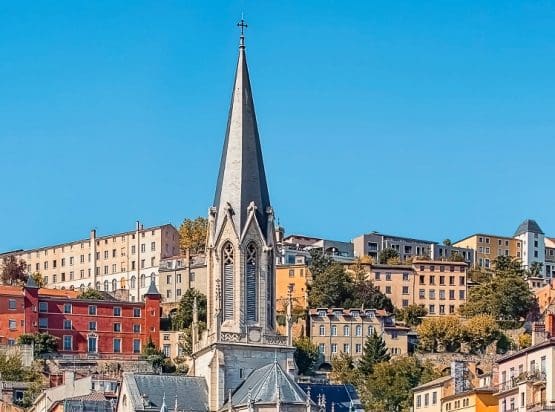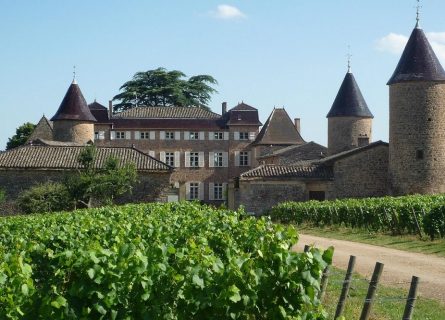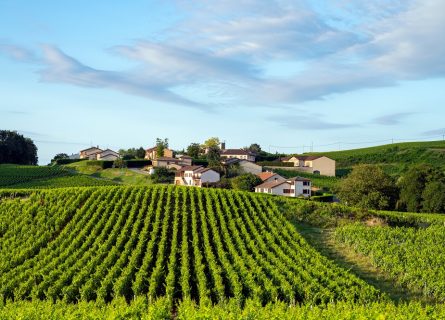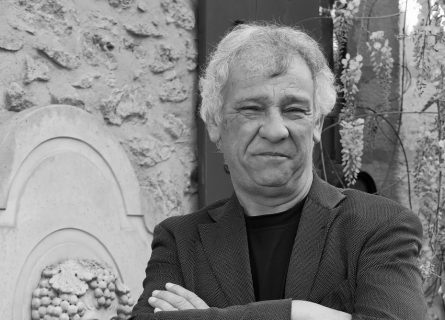Uncover Lyon's vibrant flavors and culinary gems with our expert guides. Plan an unforgettable trip now!
Read more
EXPLORE ALL OUR BURGUNDY WINE REGIONS GUIDE
Last updated: April 4, 2025
Welcome to the less glamorous (and collectible) part of Burgundy. Yet a lack of pizazz should not deter you from exploring this treasure trove of excellent value – red and white wines. Named after the pretty town of Mâcon, the southern vineyards of the Mâconnais produce a great deal of very appetizing Chardonnay: riper than the Côte d’Or due to the warmer climate and exposure.
The red wines, meanwhile, are bright, fruit-forward, and rarely expensive. Why not follow in the footsteps of Dominique Lafon (Meursault) and the late Anne-Claude Leflaive? They were the pioneering investors who saw the potential of this underrated region long ago. You won’t regret it.
Discover More About French Wine

Situated at a major crossroads between Dijon to the north and Lyon to the south, Mâcon was conquered by the Romans in the last century BC. Indeed, the forces of Rome took a particular shine to this part of Gaul (France), planting vines along the banks of the River Saône. At the height of the Western Empire’s power, the Saône was a vital gateway between the Alps and Burgundy.
Meanwhile, the Roman city of Lugdunum (Lyon) thrived as a major commercial center, founded by Julius Caesar in 44 BC. Today, you can see vestiges of this prosperous city in the two excavated Roman amphitheaters: the Grand Theater and the Odeon. It was a glorious era for viticulture in Mâcon.
However, after Rome’s authority collapsed in the 5th century, a succession of armies from northern Europe invaded the province. Yet the rising importance of Christianity in Western Europe was to be the savior of viticulture in the Mâconnais. Controlled by the bishopric of Mâcon during the Dark Ages, winegrowing became the almost exclusive domain of the Catholic Church in southern Burgundy, managed and organized by orders of Cistercian and Benedictine monks.
In 800AD, Pope Leo III crowned Charles the Great (Charlemagne) the first Holy Roman Emperor. This would prove to be very advantageous for Mâcon, as it became a border town between the Kingdom of France and the Holy Roman Empire. Trade flourished between these two superpowers, and merchants grew rich from the taxes levied on imports. As a result, the region maintained a great deal of autonomy until the 13th century. It was then sold to Louis IX of France by a destitute Alix of Bourgogne.
Yet this was not the end of the matter. In the 14th and 15th centuries, the dukes of Burgundy built one of the most powerful states in Europe, which included Flanders and, after 1435, the Mâconnais.
From the time of Philip the Bold, Burgundy, including the less prestigious vineyards of Mâcon and Beaujolais further south, prioritized viticulture. They remain a bastion of value (and increasingly quality) in the 21st century as more and more investors search for viable real estate.

Head south from Chalon (55 kilometers), and you’ll arrive in the expansive vineyards of the Mâconnais. This is a very wide, undulating, and profoundly rural area—a bucolic paradise that mass tourism has not spoiled. In this gentle scene, you’ll find a mix of viticulture and pastoral farming and a host of very pretty villages and towns.
Chardonnay is the dominant grape variety in the Mâconnais, grown in several appellations, including Mâcon-Villages, St-Veran, and Pouilly-Fuissé. The soils of the wider region—limestone overlaid with either clay or alluvial topsoil—are ideally suited to cultivating white varieties, less so red grapes.
Nevertheless, a small volume of red wine is made in the Mâconnais, typically Gamay or Pinot Noir. Historically, the Gamay wines of Mâcon were less than thrilling: rustic and hard-edged creatures that lacked fruit and finesse.
However, better site selection allied to superior winemaking is now yielding some very attractive reds in the vineyards of the Saône. But producers are increasingly replacing their Gamay vines with Pinot Noir, cashing in on the global popularity of this finicky grape. Mâcon also produces some very quaffable rosé – aromatic and very fruity.
Indeed, ripeness comes all too easily to growers in this part of Burgundy. The climate is warmer and drier than the Côte d’Or due to the region’s more southerly latitude. This tends to produce a fuller, richer expression of the Chardonnay grape, enlivened with a touch of new oak at the best domaines. Hot vintage Mâcon Blanc can taste like a halfway house between Meursault and New World Chardonnay – very textured and voluptuous.
At the same time, the best Pinot Noir offers an explosive bouquet of crushed red fruits and violets. Granted, you seldom find Montrachet’s complexity (or elegance) in the hills of the Mâconnais. The terroir does not generally rival the best climats of the Côte de Beaune. But, there is no paucity of stylish, well-made wines in the zone, whose ranks swell with every vintage.
Mâcon
This generic appellation, created in 1937, produces wines of all three colors. Any grower in the Mâconnais can access it as long as they comply with the minimum alcohol requirements and the rules pertaining to yield and production volumes. For that reason, the quality of Mâcon Blanc, Rouge, and Rosé can vary significantly. Lesser examples tend to be quite lean and one-dimensional.
However, the percentage of high-quality wine has increased exponentially in the 21st century. Today, white Mâcon is one of the great unsung heroes of Burgundy, followed closely by the local Pinot Noir. If the price is right, snap it up!
Mâcon Villages
The superior designation, Mâcon Villages, covers over 25 winemaking villages in the region. These include the greatly respected Lugny, Uchizy, and Prisse vineyards. Again, Chardonnay is the standout variety of the appellation – the permitted yields in Mâcon Villages are lower than straightforward Mâcon, and the minimum alcohol level is higher.
Thus, it is a reliable source of excellent value Chardonnay, brimming with tropical fruit and butterscotch in ripe years. As a surefire guide to quality, seek out wines sold under one of the 27 villages allowed on wine labels. Mâcon is used as the prefix, such as Mâcon-Milly-Lamartine and Mâcon-Mancey. Of these, some also have the right to produce red and rosé wines that deserve greater international recognition.
Saint-Véran
The appellation of Saint-Véran, established in 1971, exclusively dedicates itself to the production of white wines. It is perhaps one of Burgundy’s more obscure vineyards, yet it is responsible for some absolutely delicious Chardonnay whites: full-bodied and fresh.
The area under vine is found on the southern and northern fringes of the larger Pouilly-Fuissé appellation, encompassing eight communes and villages. Sandy-clay soils and a warm climate yield charming wines for short-term drinking; Chasselas and Saint-Amour tend to produce the most structured, elegant whites in Saint-Véran. Moreover, they sell at extremely attractive prices.
Pouilly-Fuissé
It is universally agreed that the best wines of the Mâconnais are made in Pouilly-Fuissé. The appellation, located north of Beaujolais, benefits from exceptional soils: a mineral-rich limestone terroir that is both porous and permeable. The south-facing, open slopes of Chaintre host some of the finest climats (vineyard sites), while Vergisson produces wines with higher acidity and poise. Generally, the best Pouilly-Fuissé exhibits a full-bodied, ripe, and structured profile, with enough acidity to balance its voluptuous, rich fruit.
That said, attitudes to oak maturation, lees stirring, and malolactic fermentation can vary wildly in the zone; Pouilly-Fuissé aged in 100% new barrique has little in common with wines matured in clay amphorae and/or cement tanks.
In September 2020, the authorities finally released their approved list of 22 Premier Cru vineyards in the region. This followed many years of campaigning from influential producers like Domaine Guffens-Heynen and Daniel Barraud. These single-vineyard bottlings have captured the imagination of critics and collectors, and not without good reason! They offer the depth and power of a great Meursault without the considerable expense.
Meanwhile, the appellation’s unofficial Grand Cru terroir is surely the captivating Roche of Solutré. It’s a steep escarpment that marks the southern end of Burgundy’s limestone plateau. The lower slopes of this iconic landmark yield wines of incomparable richness and concentration. They compare strongly to the buttery whites of Napa Valley and Sonoma in the Golden State!

Winemaking in the Mâconnais runs the gamut, from industrial methods designed for supermarket fodder to the exacting standards of Guffens-Heynen. The former involves using machine-harvested grapes and fermenting the berries quickly and painlessly in stainless steel.
Bottling relatively soon after the harvest is typical, perhaps just nine months after picking. No expensive new oak will be used, and the wines should, in theory, offer some pleasant upfront fruit. Albeit with little complexity or capacity for aging. Such wines represent the Mâconnais at its most commercial and anodyne.
Yet, plenty of artisans in the region eschew this cheap and cheerful approach. Jean-Marie Guffens is meticulous in his selection of hand-harvested grapes, discarding any bunches that are less than perfect. Then, lightly crushing the fruit increases the phenol extraction from the grape skins, leading to a more robust Chardonnay with a fuller flavor. Subsequently, pressing the berries releases free juice high in acidity, which is vital for maintaining freshness in the wines.
Meanwhile, vinification is carried out in a mixture of wooden barrels and concrete depending on the wine and the vintage. In warmer years, winemakers generally avoid malolactic fermentation because the acidity is already quite low.
A period of time in new oak (the percentage varies from year to year) adds structure and complexity to the wine. If the raw materials are first-rate, then a rival to the more prestigious appellations of the Côte de Beaune can emerge from Pouilly-Fuissé. In truth, they often represent better value than the blue-chip labels of Puligny-Montrachet, where expensive disappointments can occur.
Discover more about Burgundy Wine Classifications
Mâconnais wines were traditionally associated with simplicity and value rather than excellence – an affordable alternative to the Burgundy superstars. But, while the value description certainly holds true today, the best white wines of this complex region are far more than simply ‘first cousins’ to the Côte de Beaune.
On the contrary, they are unique expressions of the Chardonnay grape, representing a harmonious marriage between variety and terroir that defines Burgundy in the eyes of critics and aficionados. After a period of stagnation in the 20th century, the Mâconnais is now back at full throttle.
Of course, the timing is most opportune. In restaurants and retail stores worldwide, the talk is of massive price inflation in the Cote d’Or, making the top wines unaffordable for many people. And while there is still a steady demand for blue chip labels in auction houses, a growing number of buyers are seeking better value alternatives.
This is precisely what the Mâconnais delivers. Thirty years ago, Mâcon Blanc was streets ahead of the local Gamay and Pinot Noir – today, the red wines are as good as the whites, particularly regarding Mâcon-Villages. Controlling yields make Mâconnais Pinot Noir utterly delicious and approachable, with crunchy fruit and silky tannins.
The Gamay, too, can be really excellent: soft wines with lovely aromatics and the presence of a Beaujolais Cru. The run of good vintages, meanwhile, continues unbroken. Somewhere between the Cote d’Or’s classicism and the New World’s ripeness seems to be a fair assessment of what the Mâconnais offers in 2024. Ideally, every restaurant would have a healthy selection of Mâcon, Saint-Véran, and Pouilly-Fuissé on its wine list. The price-to-quality ratio is simply unbeatable.
Chardonnay is a green-skinned grape varietal native to the Burgundy wine region in France and one of the most popular varieties worldwide.
Find out moreGamay Noir is a grape variety used to make light-bodied red wine, most notably grown in the Beaujolais region.
Find out morePinot noir is a light-bodied red wine varietal closely related to the Vitis vinifera grape and produces the most sought-after red wines in the world.
Find out moreThe Burgundians take few things in life as seriously as a good meal. Thus, talented chefs in Mâconnais guarantee memorable dining by making the most of fantastic local ingredients, including Bresse chicken, Charolais beef, and Dijon mustard. Your best bet is one of the many bistros of Mâcon or the always lively bouchons of Lyons further south.
A Gastronomic Guide to the Cuisine of Burgundy: Read more
If you would like us to customize an exclusive luxury tour, contact us and let us know your travel plans. We offer luxury food and wine tours for private groups of a mininium two guests. In addition, all of our private, chauffeured tours are available year-round upon request.

